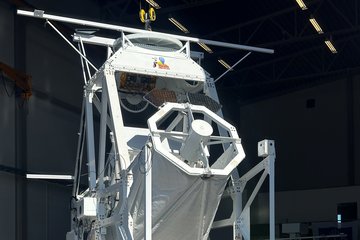All genres
61.
Talk
Habitability of early Earth: Liquid water under a faint young Sun and tidal heating due to a closer Moon. General Meeting of the SPP 1833 "Building a Habitable Earth", online (2021)
62.
Talk
Ursprung – Kann etwas aus dem Nichts entstehen? Podiumsdiskussion (Ringvorlesung der Georg-August-Universität Göttingen), online (2021)
63.
Talk
Extrasolare Planeten. Helene-Lange-Schule Hannover, online (2021)
64.
Talk
Challenges of Validating Earth-like Transiting Planets Around Sun-like Stars. Splinter session "Exploring the diversity of extrasolar planets”, Virtual Meeting of the German Astronomical Society (2020)
65.
Talk
Pluto for planet. Planetarium Hamburg, Hamburg, Germany (2020)
66.
Talk
Extrasolare Planeten. Helene-Lange-Schule Hannover, Hannover, Germany (2020)
67.
Talk
Homing in on Earth-like planets beyond the solar system. Konkoly Observatory, Budapest, Hungary (2019)
68.
Talk
Argumented Reality @Sartorius. WORK LIFE SPACE. Sartorius Campus , Göttingen, Germany (2019)
69.
Talk
Wie findet man einen Exoplaneten? Max-Planck-Institut für Sonnensystemforschung, Göttingen, Germany (2019)
70.
Talk
Extrasolare Monde – schöne, neue Welten? Planetarium Hamburg, Hamburg, Germany (2019)
71.
Talk
On-ground Outlier Detection Algorithms Over Light Curves Using Spatial Redundancy. PLATO week 9, Marseille, France (2019)
72.
Talk
Observations of Extrasolar Planets and Formation of Planets in Protoplanetary Discs. Queen Mary University, London, UK (2019)
73.
Talk
Von Eiswelten, Vulkanhöllen und unterirdischen Ozeanen. Planetarium Hamburg, Hamburg, Germany (2019)
74.
Talk
Detecting shallow transits with smart force: the Transit Least Squares (TLS) algorithm. PLATO Extrasolar Planets 2019: Single, Shallow & Strange Transits, Warwick , UK (2019)
75.
Talk
Extrasolare Planeten. Max-Planck-Institut für Sonnensystemforschung, Schülerbesuch der 11. Klasse des Felix-Klein-Gymnasium Göttingen, Göttingen, Germany (2019)
76.
Talk
PLATO On-ground Outlier Detection Algorithm Over Imagettes. PLATO Week 8, Graz, Austria (2019)
77.
Talk
In situ-Erkundung extrasolarer Planeten Science Fiction oder Science Fact? Vortragsreihe "Extrasolare Planeten, Astrobiologie und die Frage nach Leben im Universum" der Akademie der Wissenschaften, Hamburg, Germany (2019)
78.
Talk
How to park a hot Jupiter at 0.05 AU around a sun-like star for billions of years. Planet Formation and Evolution 2019, Rostock, Germany (2019)
79.
Talk
On-ground Outlier Detection Algorithms for Imagettes and L0 Light Curves (remotely). PLATO Week 7, Cambridge, UK (2019)
80.
Talk
The Perils and Merits of Living with Tidal Heating. Heidelberg Initiative for the Origin of Life, Heidelberg, Germany (2018)











